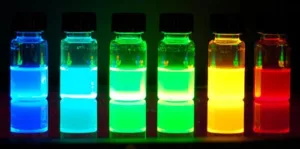Advances in quantum dot (QD) manufacturing, by Oregon State University, may lead to a new generation of LED lighting. Researchers on the project say that the light produced could be a soft white, and the system would use a low-cost manufacturing process and fewer toxic materials. The same technology can also be applied to display backlights.
According to the researchers, the cost, environmental and performance improvements in their QD-LED lights could cut the USA’s lighting bill almost in half, compared to incandescent and fluorescent lighting. Unlike many mass-produced QDs today, the OSU components do not use cadmium (a toxic metal). Inside, the system is based on copper indium diselenide.
Key to the new process is the use of a ‘continuous flow’ chemical reactor, as well as microwave heating technology. The continuous flow system is ‘fast, cheap [and] energy efficient’. Microwave heating enables precise control of the heat required during the production process, and can be used to create nanoparticles of exactly the right size, shape and composition.
It is thought that display products using this technology will use less power, and thus last longer on a charge.

